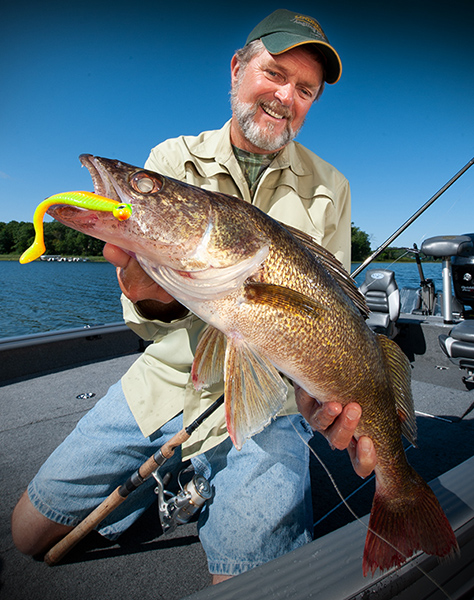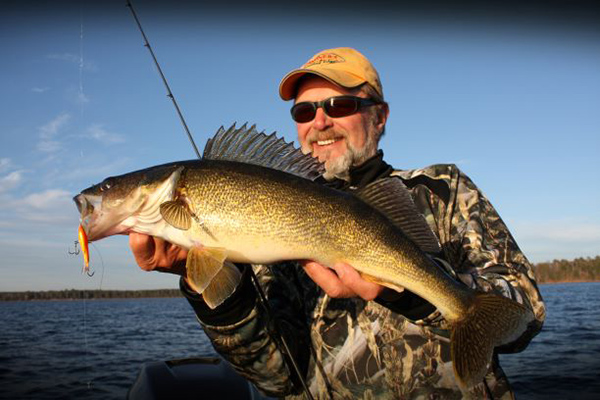Provided by Rapala
 Lindner Shares Tips for Tough Summertime Walleye Bite
Lindner Shares Tips for Tough Summertime Walleye Bite
Walleyes in the wrong place and not biting what they should be this summer?
You’re not alone! But fear not, Al Linder is here to share three can’t-miss tactics to put ‘eyes into your boat – and without live bait.
“Talking to the guides and a lot of the people we know all over the Midwest, everybody has said this has been the strangest year any of us have ever seen for catching walleyes,” acknowledges Lindner, legendary co-founder of In-Fisherman and host of the influential Angling Edge and Fishing Edge TV shows. “On average, it’s been a tough bite, but we still have lots of fish to catch.”
The following three bites, Linder says, are on now pretty reliably in Minnesota’s famed Walleye factories like Otter Tail, Leech, Mille Lacs, Red, Cass and Vermilion, as well as in lakes like them throughout the Upper Midwest: Weed bite, Structure Bite and Suspended Bite.
“Those three things are all happening at the same time,” Linder says. “Not every walleye in the lake is always doing the same thing at the same depth. There’s a lot of fish that do a lot of different things. And that holds true all the time.”
Weed Bite
In most of the larger lakes known as go-to walleye destinations, there’s always an active population of weed walleyes, Lindner says. “Day in, day out, you can catch ‘em in the middle of any weeds sparse enough to be fishable and pull a bait through,” he says.
Linder’s favorite way to catch walleyes in the weeds is casting a VMC Neon Moon Eye Jig dressed with a boot-tail or split-tail soft-plastic grub. Target weeds in 8 to 12 feet of water in low-light periods.
“That population of fish is active earlier and late in the day,” Lindner says. “They get out of the denser weeds and they’ll come up near the surface, rise high in the weeds, and they’ll come out to the edges.”
An improved take on a traditional Aspirin-shaped jig-head, VMC’s Moon Eye Jig provides added control on the fall and features 3-D holographic eyes for realism and the illusion of a wider profile.
Structure Bite
An entirely separate population of walleyes are “Jigging Rap” fish, Linder says. These are the ‘eyes that spend the summer tight to deep structure – currently deeper than usual in many places. “On a lot of these lakes, those structure fish are around 25 feet, but I’ve heard of bites going as deep as 40 feet already,” he says. “That’s astounding.”
The winners of a recent walleye tournament on Ottertail, for example, caught their best fish in 35 to 40 feet. “I was amazed,” Lindner says. “The big fish all came deep. Deeper than normal – deeper than most of us had expected. And we’re hearing that’s true for a number of our lakes here in the Brainerd area.”
When walleyes are hugging bottom that deep, few baits catch them better than a Rapala Jigging Rap. “Day in, day out, it’s the go-to bait,” he says. “Nothing can trigger those fish faster and better.”
Long predominant as ice-fishing lures, Jigging Raps were proven equally productive as open-water baits in the last several years by Lindner and some others. Featuring a balanced, weighted minnow profile, Jigging Raps swim in tantalizing circles on the fall, inimitably simulating the erratic characteristics of a wounded baitfish. When fished through the ice as they were designed for, they work best with a vertical pump-and-swim action. A successful open-water presentation, however, requires aggressive rod snaps throughout a horizontal retrieve.
Not every area of 25 to 40 feet of water will hold a population of active walleyes. This bite requires a good sonar/GPS unit with a quality contour map. Navigate to reefs or humps surrounded by deeper water that top out between 25 and 40 feet and fish only where you see schools of fish or bait on your sonar screen. “If you hunt for them with your electronics, you’ll find them,” Lindner says. “They stick out when they’re there.”
Suspended Bite
A third population of walleyes spend much of the summer suspended in the open water of deep basins, chasing baitfish. “So forget what you know about structure and throw a No. 9 Shad Rap over the back of the boat, stick your rod in a rod holder, leave a lot of line out and just start trolling in the middle of nowhere,” Lindner says.
 Lindner Shares Tips for Tough Summertime Walleye Bite
Lindner Shares Tips for Tough Summertime Walleye Bite
A No. 9 Shad Rap measures 3 ½ inches and will run 8 to 15 feet deep.
Suspended walleyes are usually most active in the evening. And they’re usually big.
“You don’t go out there and catch too many eaters doing this,” Lindner says. “This is a big-fish bite. The big ones are generally eating tullibee, smelt or whitefish.”
If Lindner observes baitfish breaking on the surface in the evening, he’ll reel in his Shad Rap and troll a No. 11 Original Floating Rapala on a planer board at ten feet or shallower in basins as deep as 40 to 100 feet.
“You would be amazed at what you catch doing this for a couple hours in the evening,” Lindner says. “In the last five years, a lot of anglers have been tuning into this.”
A No. 11 Original Floating Rapala measures 4 3/8 inches and will run 4 to 6 feet deep.





